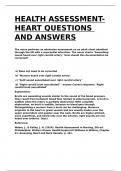HEALTH ASSESSMENT-
HEART QUESTIONS
AND ANSWERS
The nurse performs an admission assessment on an adult client admitted
through the ED with a myocardial infarction. The nurse charts "Swooshing
sound heard over right carotid artery." How should this documentation be
corrected?
a) Does not need to be corrected
b) "Murmur heard over right carotid artery"
c) "Split sound auscultated over right carotid artery"
d) "Right carotid bruit auscultated" - answer Correct response: "Right
carotid bruit auscultated"
Explanation:
Bruits are swooshing sounds similar to the sound of the blood pressure.
They result from turbulent blood flow related to atherosclerosis. A bruit is
audible when the artery is partially obstructed. With complete
obstruction, no bruit is audible, because no blood gets through.
Distinguishing a murmur from a bruit can be challenging. Murmurs
originate in the heart or great vessels and are usually louder over the
upper precordium and quieter near the neck. Bruits are higher pitched,
more superficial, and heard only over the arteries. Split sounds are not
heard over arteries. (less)
Reference:
Weber, J., & Kelley, J. H. (2014). Health Assessment in Nursing, 5th ed.
Philadelphia: Wolters Kluwer Health/Lippincott Williams & Wilkins, Chapter
21: Assessing Heart and Neck Vessels, p. 431.
,During an interview with the nurse, a client complains of a fatigue that
seems to get worse in the evening. Which of the following causes of
fatigue would explain this pattern?
a) Decreased cardiac output
b) Depression
c) Severe muscular exertion
d) Upper respiratory infection - answer Correct response: Decreased
cardiac output
Explanation:
Fatigue may result from compromised cardiac output. Fatigue related to
decreased cardiac output is worse in the evening or as the day
progresses, whereas fatigue seen with depression is ongoing throughout
the day. Severe muscular exertion and an upper respiratory infection may
be associated with fatigue, but not the pattern mentioned in the scenario.
(less)
Reference:
Weber, J.R., & Kelley, J.H. Health Assessment in Nursing, 5th ed.,
Philadelphia: Wolters Kluwer Health/Lippincott Williams & Wilkins, 2014,
Chapter 21: Assessing Heart and Neck Vessels, p. 424.
In order to palpate an apical pulse when performing a cardiac assessment,
where should the nurse place the fingers?
a) left midclavicular line at the fifth intercostal space
b) right of the midclavicular line at the third intercostal space
c) left midclavicular line at the third intercostal space
d) right of midclavicular line at the fifth intercostal space - answer Correct
response: left midclavicular line at the fifth intercostal space
Explanation:
The apical pulse is the point of maximal impulse and is located in the fifth
intercostal space at the left midclavicular line when the client is placed in
a sitting position. The apical impulse is palpated in the mitral area and
therefore cannot be palpated at the left midclavicular line at the third
intercostal space, at right of the midclavicular line at the third intercostal
, space and at right of the midclavicular line at the fifth intercostal space.
(less)
Reference:
Weber, J., & Kelley, J. H. (2014). Health Assessment in Nursing, 5th ed.
Philadelphia: Wolters Kluwer Health/Lippincott Williams & Wilkins, Chapter
21: Assessing Heart and Neck Vessels, p. 432.
The client has been diagnosis with severe sepsis. Which finding would
indicate the client is experiencing low cardiac output?
a) Bradycardia; hypertension
b) Tachycardia; hypotension
c) Bradycardia; hypotension
d) Tachycardia; hypertension - answer Correct response: Tachycardia;
hypotension
Explanation:
A low cardiac output would be exhibited by tachycardia and hypotension.
Reference:
Weber, J., and Kelley, J. Health Assessment in Nursing, 5th ed.,
Philadelphia: Wolters Kluwer Health, 2014, Chapter 21: Assessing Heart
and Neck Vessel, pg. 422.
Where are the heart and great vessels located in the human body?
a) The mediastinum, between the lungs below the diaphragm
b) The mediastinum, between the lungs above the diaphragm
c) The peritoneum, below the diaphragm
d) The peritoneum, above the diaphragm - answer Correct response: The
mediastinum, between the lungs above the diaphragm
Explanation:
The heart and great vessels are located in the mediastinum between the
lungs and above the diaphragm from the center to the left of the thorax.
Therefore, the other options are incorrect. (less)




